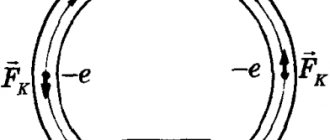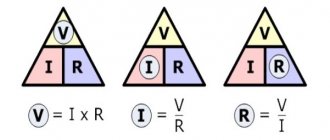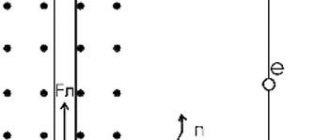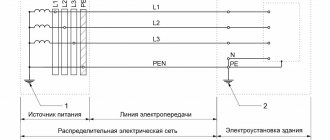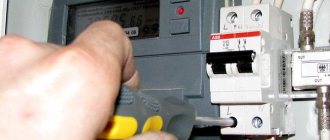The author of the article is a professional tutor, author of textbooks for preparing for the Unified State Exam Igor Vyacheslavovich Yakovlev
Topics of the Unified State Examination codifier: electromotive force, internal resistance of a current source, Ohm's law for a complete electrical circuit.
Until now, when studying electric current, we have considered the directional movement of free charges in an external circuit
, that is, in the conductors connected to the terminals of the current source.
As we know, positive charge:
• goes into the external circuit from the positive terminal of the source;
• moves in an external circuit under the influence of a stationary electric field created by other moving charges;
• comes to the negative terminal of the source, completing its path in the external circuit.
Now our positive charge needs to close its path and return to the positive terminal. To do this, he needs to overcome the final segment of the path - inside the current source from the negative terminal to the positive. But think about it: he doesn’t want to go there at all! The negative terminal attracts it towards itself, the positive terminal repels it from itself, and as a result, our charge inside the source is acted upon by an electric force directed against
movement of the charge (i.e. against the direction of the current).
Third party force
Nevertheless, current flows through the circuit; therefore, there is a force that “pulls” the charge through the source despite the resistance of the electric field of the terminals (Fig. 1).
Rice. 1. Third party force
This force is called a third party force
;
It is thanks to it that the current source functions. The external force has nothing to do with the stationary electric field - it is said to be of non-electrical
origin; in batteries, for example, it arises due to the occurrence of appropriate chemical reactions.
Let us denote by the work of an external force to move a positive charge q inside the current source from the negative terminal to the positive. This work is positive, since the direction of the external force coincides with the direction of charge movement. The work of an external force is also called the work of a current source
.
There is no external force in the external circuit, so the work done by the external force to move the charge in the external circuit is zero. Therefore, the work of an external force to move a charge around the entire circuit is reduced to the work of moving this charge only inside the current source. Thus, this is also the work of an external force to move charge throughout the circuit
.
We see that the external force is non-potential - its work when moving a charge along a closed path is not zero. It is this non-potentiality that allows the electric current to circulate; a potential electric field, as we said earlier, cannot support a constant current.
Experience shows that work is directly proportional to the charge being moved. Therefore, the ratio no longer depends on the charge and is a quantitative characteristic of the current source. This relationship is denoted by:
(1)
This quantity is called electromotive force
(EMF) of the current source. As you can see, EMF is measured in volts (V), so the name “electromotive force” is extremely unfortunate. But it has long been ingrained, so you have to come to terms with it.
When you see the inscription on the battery: “1.5 V”, then know that this is exactly the EMF. Is this value equal to the voltage created by the battery in the external circuit? It turns out not! Now we will understand why.
What is internal resistance
An electrical circuit must have a power source. Usually, when evaluating its parameters, they indicate what potential difference it provides between the terminals. If we talk about an ideal model of a power source, we can assume that it is capable of providing any power in an electrical circuit, taking into account the existing potential difference.
Real devices differ greatly in this aspect. To determine the performance of a battery, it is important to know what internal resistance is. It usually increases gradually over time and due to wear and tear. By analyzing the level and rate of how the internal resistance of the current source changes, you can decide whether to continue using the battery or whether it needs to be replaced.
This should be illustrated with an example. A 12 Volt battery is used to start the car engine. It is known that the current can reach 250 Amperes. However, if you take another battery with the same potential difference, then it is quite possible that it will not start the motor.
As an example of such a source, we can consider several galvanic cells connected in series. The difference in the two situations under consideration is determined by the presence of different internal resistance.
This parameter for a battery is the sum of several terms: the resistance of each terminal, the housing and the electrolyte used. In some current sources, additional elements included in this circuit may be taken into account.
It is important to consider that the concept of ohmic resistance is not applicable in this situation, since only passive elements are required in the circuit. When a closed circuit is created, current flows not only through it, but also inside the current source. Internal resistance determines the amount of energy loss in it.
Its presence in the circuit can be illustrated with another example. If there are 12 volts at the battery terminals, then at first glance you can easily predict what current strength will be with a load of 1 ohm. Obviously, you should expect a current of 12 Amps to pass through the circuit.
In fact, this statement is not true: the current will be slightly less - approximately 11.2 Amperes. There is no discrepancy with physics here. After all, when calculating, it is additionally necessary to take into account the resistance of the current source, due to which energy consumption occurs. It is called internal. It can be mentally imagined as a resistor connected in series with a current source.
Ohm's law for a complete circuit
Any current source has its own resistance, which is called internal resistance
this source. Thus, the current source has two important characteristics: emf and internal resistance.
Let a current source with an emf equal to and internal resistance be connected to a resistor (which in this case is called an external resistor
, or
external load
, or
payload
).
All this together is called a complete chain
(Fig. 2).
Rice. 2. Complete circuit
Our task is to find the current in the circuit and the voltage across the resistor.
Over time, a charge passes through the circuit. According to formula (1), the current source does the following work:
(2)
Since the current strength is constant, the work of the source is entirely converted into heat, which is released at the resistances and. This amount of heat is determined by the Joule–Lenz law:
(3)
So, , and we equate the right-hand sides of formulas (2) and (3):
After reducing by we get:
So we found the current in the circuit:
(4)
Formula (4) is called Ohm's law for a complete circuit
.
If you connect the terminals of the source with a wire of negligible resistance, you will get a short circuit
.
In this case, the maximum current will flow through the source - short circuit current
:
Due to the small internal resistance, the short circuit current can be quite large. For example, a AA battery gets so hot that it burns your hands.
Knowing the current strength (formula (4)), we can find the voltage across the resistor using Ohm’s law for a section of the circuit:
(5)
This voltage is the potential difference between points and (Fig. 2). The potential of the point is equal to the potential of the positive terminal of the source; the potential of the point is equal to the potential of the negative terminal. Therefore, voltage (5) is also called voltage at the source terminals
.
We see from formula (5) what will happen in a real circuit - after all, it is multiplied by a fraction less than one. But there are two cases when .
1. Ideal current source
. This is the name of a source with zero internal resistance. When formula (5) gives .
2. Open circuit
. Let's consider the current source by itself, outside the electrical circuit. In this case, we can assume that the external resistance is infinitely large: . Then the quantity is indistinguishable from , and formula (5) again gives us .
The meaning of this result is simple: if the source is not connected to the circuit, then a voltmeter connected to the poles of the source will show its EMF
.
From electrostatics to electrokinetics
Between the end of the 18th and the beginning of the 19th century, the work of scientists such as Coulomb, Lagrange and Poisson laid the mathematical foundations for the determination of electrostatic quantities. Progress in the understanding of electricity at this historical stage is obvious. Franklin had already introduced the concept of “amount of electrical substance,” but so far neither he nor his successors have been able to measure it.
Following Galvani's experiments, Volta tried to find evidence that the animal's "galvanic fluids" were of the same nature as static electricity. In his search for truth, he discovered that when two electrodes of different metals come into contact through an electrolyte, both become charged and remain charged despite the circuit being closed by the load. This phenomenon did not correspond to existing ideas about electricity because electrostatic charges in such a case had to recombine.
Volta introduced a new definition of the force acting in the direction of separating charges and maintaining them in this state. He called it electromotive. Such an explanation for the description of battery operation did not fit into the theoretical foundations of physics at that time. In the Coulomb paradigm of the first third of the 19th century. d.s. Volta was determined by the ability of some bodies to generate electricity in others.
Ohm made the most important contribution to the explanation of the operation of electrical circuits. The results of a series of experiments led him to the construction of the theory of electrical conductivity. He introduced the quantity “voltage” and defined it as the potential difference across the contacts. Like Fourier, who in his theory distinguished between the amount of heat and temperature in heat transfer, Ohm created a model by analogy relating the amount of charge transferred, voltage and electrical conductivity. Ohm's law did not contradict the accumulated knowledge of electrostatic electricity.
You may be interested in this Definition of Ohm's law applied to a complete circuit
Then, thanks to Maxwell and Faraday, explanatory models of current received a new field theory. This allowed the development of a field-related energy concept for both static potentials and electromotive force. The main dates for the evolution of the concept of EMF:
- 1800 - creation of the Voltaic galvanic battery;
- 1826 - Ohm formulates his law for a complete chain;
- 1831 - discovery of electromagnetic induction by Faraday.
Electrical circuit efficiency
It's not hard to see why a resistor is called a payload. Imagine it's a light bulb. The heat generated by a light bulb is beneficial
, since thanks to this warmth the light bulb fulfills its purpose - giving light.
Let us denote the amount of heat released by the payload during time .
If the current in the circuit is equal to , then
A certain amount of heat is also released at the current source:
The total amount of heat released in the circuit is equal to:
Electrical circuit efficiency
is the ratio of useful heat to total heat:
The efficiency of the circuit is equal to unity only if the current source is ideal.
We explain the essence of EMF “on the fingers”
To understand what is what, we can give an example-analogy. Let's imagine that we have a water tower completely filled with water. Let's compare this tower with a battery.
Water exerts maximum pressure on the bottom of the tower when the tower is completely filled. Accordingly, the less water in the tower, the weaker the pressure and pressure of the water flowing from the tap. If you open the tap, the water will gradually flow out, first under strong pressure, and then more and more slowly until the pressure weakens completely. Here, tension is the pressure that water exerts on the bottom. Let us take the very bottom of the tower as the zero voltage level.
It's the same with the battery. First, we connect our current source (battery) to the circuit, closing it. Let it be a watch or a flashlight. As long as the voltage level is sufficient and the battery is not discharged, the flashlight shines brightly, then gradually goes out until it goes out completely.
But how to make sure that the pressure does not dry out? In other words, how to maintain a constant water level in the tower, and a constant potential difference at the poles of the current source. Following the example of the tower, the EMF is represented as a pump that ensures the influx of new water into the tower.
Table of resistivities of various materials
| Specific resistance ρ, Ohm*mm2/m | Specific resistance ρ, Ohm*mm2/m |
| Aluminum | 0,028 |
| Bronze | 0,095 – 0,1 |
| Bismuth | 1,2 |
| Tungsten | 0,05 |
| Iron | 0,1 |
| Gold | 0,023 |
| Iridium | 0,0474 |
| Constantan (Ni-Cu + Mn alloy) | 0,5 |
| Brass | 0,025 – 0,108 |
| Magnesium | 0,045 |
| Manganin (alloy of copper, manganese and nickel – instrument) | 0,43 – 0,51 |
| Copper | 0,0175 |
| Molybdenum | 0,059 |
| Nickel silver (an alloy of copper, zinc and nickel) | 0,2 |
| Sodium | 0,047 |
| Nickelin (an alloy of copper and nickel) | 0,42 |
| Nickel | 0,087 |
| Nichrome (an alloy of nickel, iron chromium and manganese) | 1,05 – 1,4 |
| Tin | 0,12 |
| Platinum | 0.107 |
| Mercury | 0,94 |
| Lead | 0,22 |
| Silver | 0,015 |
| Steel | 0,103 – 0,137 |
| Titanium | 0,6 |
| Hromal | 1,3 – 1,5 |
| Zinc | 0,054 |
| Cast iron | 0,5-1,0 |
Answer: The filament is made of constantan.

